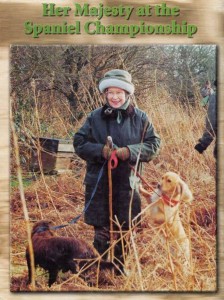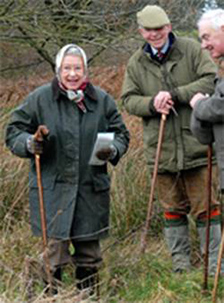Hunting with your spaniel – Putting it all together!
( published in Spaniels In The Field – summer 2003 )
You have finally made it through the dog days of summer with your spaniel. Maybe you have a young pupil who you have worked all summer with preparing them for fall bird season. Or perhaps you have a seasoned veteran who you have brushed up their skills. Now is the moment of truth, hunting wild birds in wild bird places.
Let’s face it. Bird hunting trips are only as fun as the dogs and people we are with. A dog soon separates when it is training and hunting and a disobedient dog can make a hunting trip just downright miserable. They are worse than bad company.
A young dog may be tempted to riot in the face of some very different surroundings than the familiar training grounds. Or the seasoned dog may become more and more unruly as the season progresses. How do we maintain the good habits we worked so hard for in training and yet enjoy ourselves?
Before you pack up and head out to go hunting with your pup lets discuss what they should be doing. During the summer we spend a lot of time with the youngsters properly building the foundation for our training program. They are worked daily in the yard in basic obedience such as hup, stay, recall, retrieving, kenneling etc. Good response to these commands are essential not only for a good day afield but for pups safety.
Next they are taught proper pattern. A flushing dog that continually hunts out of gun range is useless. We make sure they find lots of birds while working an appropriate pattern for the cover and wind. Our program is reward based. Hunt within range and you find birds and get lots of retrieves.
We usually introduce pups to quartering and retrieving on pigeons. Once they are working well on pigeons we move on to game birds such as pheasants or chuckar. I like to take the youngsters for walks where they will encounter wild game prior to the season opener. I usually get in some early scouting and pup gets some work on game birds awakening the nose a bit more than a pigeon.
When appropriate we introduce gunshot. Improper shooting over a young dog can turn off even a hard charging spaniel. It can be prevented with a little care and training. Sometimes folks get so wrapped up in shooting they forget there is a dog down field which may not like getting the muzzle blast. We introduce the shot in progressive steps, which the dog associates with a retrieved bird.
Some folks hunt a season or two with their spaniel unsteady to wing and shot before steadying them. If you are going to hunt over an unsteady spaniel make sure they come back after a short chase. You can setup a drill while training by having them flush a bird, chase a short distance then hit the recall whistle and when you get their attention throw a dead bird or clip wing for them to retrieve. The idea is that when they come back promptly they get a reward.
Wild birds tempt a bit more than in training. Circum-stances are a bit less controlled and sometimes you may go for hours before encountering game. Here are some tips I share with our clients to have a more enjoyable hunt with your young or old spaniel.
Training and hunting…….treat it all the same.
Many folks make the mistake of letting a dog get away with things while hunting they would not tolerate while training. Treat it all the same and you will be rewarded with not only consistency but less chances of having to correct bad habits gained while hunting.
If you expect pup to retrieve to hand in training than expect no less when hunting. The same with steadiness to flush and shot or turning when asked etc. This enhances not only overall hunting but also your training program. Dogs like consistency, it is less confusing to them and if you have to correct them they clearly know the expectations and you oftentimes have a better performer.
One of the best hunting dogs I ever had the pleasure of shooting over was not so much fun on his first hunting trip. We had longtails flying everywhere with a very excited spaniel behind all of them. Several years later during one of my hunts to “Big Sky country” this same dog produced over 100 birds to the gun never missing a beat. Truly a pleasure to hunt over for many years. Consistency in training and hunting paid off.
I often take a friend or client with me to let them shoot giving me the opportunity to focus on the dog for the first couple of hunts or I may carry a gun with little expectation of use. Instruct all those involved as to what your expectations are and stick to it. Personally I usually do not shoot a bird the dog does not produce or if things are really going sour I hold back on shooting altogether. This is tough. Especially if all you may see for the day is a couple of birds! Believe me it will be worth it throughout the years. Stick to your program.
Our training program is reward based. If the pup listens up and works for the gun they get birds and retrieves. I often will carry a clip wing pigeon or something we often use in training for retrieving to reward a young dog occasionally during the hunt. I may toss it in for a find for the youngster if we are going a distance between birds or if we are unable to bring down a bird for them. You can do the same with a bird you have shot earlier to keep up the excitement.
Have a plan………..
I try to pocket hunt the youngsters. What I mean is I hit bird covers where I stand a better than average chance of finding birds. These small pockets often take 30 – 60 minutes to hunt and I usually work cover where I can keep them out of trouble a bit more than a more seasoned veteran. This keeps the enthusiasm positive and puts them in the field when they are freshest. As they get more and more confidence we run them longer and longer. Use the rest time to run another dog or to scout out new grounds.
Early season bird hunts are notorious for being hot. Consider hunting along a creek or watershed and always carry a bit of water to give your partner a well-deserved drink. The younger pups usually are very poor about pacing themselves during the hunt and can easily get overheated during the excitement. A dog breathing heavily out of their mouth usually does not smell well anyway. Keep a good eye on them and take extra rest stops if need be especially during the early season.
This is where summer conditioning really helps a lot. Even the youngsters need to be acclimated to the conditions of hunting. We have a year round conditioning program, which cannot be emphasized enough for both dogs and owners alike.
Don’t ask too much
too soon………..
Often we are so excited to get the youngster out on wild birds that we forget that they are just in the beginning of their hunting years. Don’t expect to be able to go out and work for eight hours straight with a pup that is just beginning of their career. A trip to the Dakota’s with a nine-month-old pup may be a bit much for most dogs.
Take some time to let them know they are doing great and enjoy your hunting partner…
– Jim Keller
Jim Keller and his wife Denise own and operate Wildwind Kennels located in the heart of grouse and woodcock country in mid-coastal Maine. They work with all bird dog breeds specializing in flushing spaniels. Jim is a full time dog trainer with over 17 years of experience working with bird dogs for hunting and performance events. We campaign a limited group of spaniels in the US and Canada in Field Trials having made several field champions, and we actively participate in the Hunt Test program. Jim is also a registered Maine guide working for some of the finest sporting camps in Maine’s northwoods for grouse and woodcock. Jim can be reached at:
Jim Keller – Wildwind Kennel
1368 Webb RD – Knox, Maine 04986



